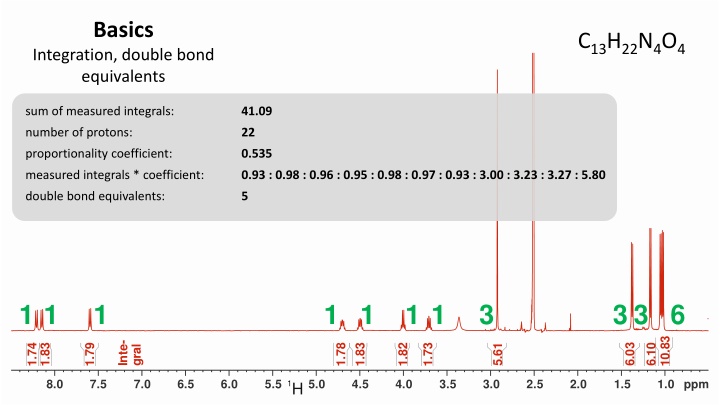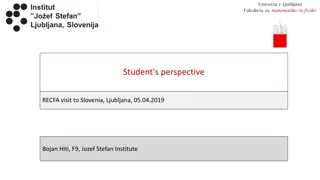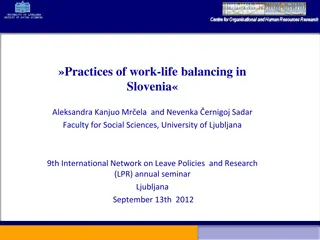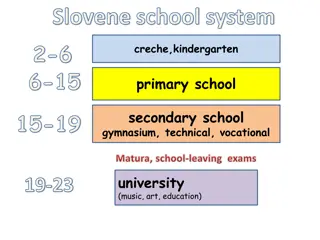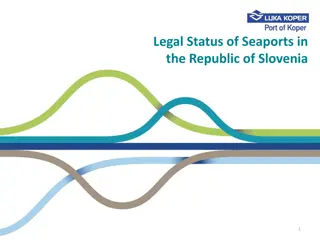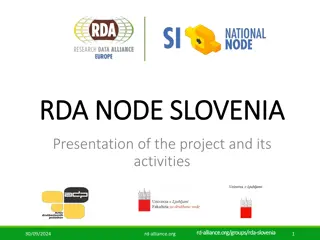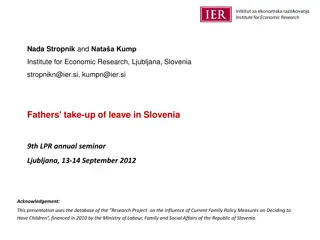Family Policy Analysis in Slovenia
The analysis focuses on family policy in Slovenia, covering areas such as family allowances, health, employment, housing, and preschool education. It provides insights into family composition trends, maternity and paternity leave durations, and parental leave uptake in the country. The data highlights the changing dynamics of families in Slovenia and the impact of policies on parental decisions.
Download Presentation

Please find below an Image/Link to download the presentation.
The content on the website is provided AS IS for your information and personal use only. It may not be sold, licensed, or shared on other websites without obtaining consent from the author.If you encounter any issues during the download, it is possible that the publisher has removed the file from their server.
You are allowed to download the files provided on this website for personal or commercial use, subject to the condition that they are used lawfully. All files are the property of their respective owners.
The content on the website is provided AS IS for your information and personal use only. It may not be sold, licensed, or shared on other websites without obtaining consent from the author.
E N D
Presentation Transcript
Basics C13H22N4O4 Integration, double bond equivalents sum of measured integrals: 41.09 number of protons: 22 proportionality coefficient: 0.535 measured integrals * coefficient: 0.93 : 0.98 : 0.96 : 0.95 : 0.98 : 0.97 : 0.93 : 3.00 : 3.23 : 3.27 : 5.80 double bond equivalents: 5 1 1 1 1 1 1 1 3 3 3 6 10.83 Inte- 6.03 1.74 1.83 1.79 1.78 1.83 1.82 1.73 5.61 6.10 gral 8.0 7.5 7.0 6.5 6.0 5.5 5.0 4.5 4.0 3.5 3.0 2.5 2.0 1.5 1.0 ppm 1H
Basics C13H22N4O4 Number of amino acids double bond equivalents: 5 number of >C=O groups: 4 (171.41, 171.53, 171.92, 172.16 ppm) Please note: all oxygen atoms are used now, no OH group is possible. double bond equivalents: 5 30.20 18.14 171.53 171.92 17.47 18.89 16.63 53.97 50.40 44.62 44.84 171.41 172.16 ~~ ~~ 175 170 50 45 40 35 30 25 20 ppm 13C
Basics Number of amino acids double bond equivalents: 5 number of >C=O groups: 4 (171.41, 171.53, 171.92, 172.16 ppm) no OH possible 117 117 number of >NH groups (HSQC): Please note: all oxygen atoms are used now, no OH group is possible. 4 (one nitrogen atom is not directly bonded to H) 3 (-NH protons between 7.5 and 8.5 ppm) 118 118 number of N atoms (from HMBC): 119 119 119.8 119.8 120 120 121 121 121.1 121.1 1H/15N-HMBC recorded at 500.13/50.70 MHz 122 122 122.4 122.4 123 123 15N 15N 1H/15N-HSQC 124.3 recorded at 500.13/50.70 MHz 125 125 8.4 8.3 8.2 8.1 8.0 7.8 7.7 7.6 7.5 ppm 3.4 3.0 2.6 2.2 1.4 1.0 0.6 ppm 1H 1H
Basics XHn groups C13H22N4O4 double bond equivalents: 5 number of >C=O groups: 4 (171.41, 171.53, 171.92, 172.16 ppm) no OH possible number of >NH groups (HSQC): 3 ( NH protons between 7.5 and 8.5 ppm) number of N atoms (from HMBC): 4 (one nitrogen atom is not directly bonded to H) Finally three H are directly bonded to nitrogen and all other proton signals belong to CHn groups. > CHn > NH 1 1 1 1 1 1 1 3 3 3 6 10.83 Inte- 6.03 1.74 1.83 1.79 1.78 1.83 1.82 1.73 5.61 6.10 gral 8.0 7.5 7.0 6.5 6.0 5.5 5.0 4.5 4.0 3.5 3.0 2.5 2.0 1.5 1.0 ppm 1H
Basics C13H22N4O4 Double bond equivalents revisited double bond equivalents: 5 number of >C=O groups: 4 (171.41, 171.53, 171.92, 172.16 ppm) no OH possible number of >NH groups (HSQC): 3 ( NH protons between 7.5 and 8.5 ppm) number of N atoms (from HMBC): 4 (one nitrogen atom is not directly bonded to H) There are no sp2 hybridized carbon atoms other than the carbonyl groups. Were is the fifth double bond equivalent? 30.20 18.14 171.53 171.92 17.47 18.89 16.63 53.97 50.40 44.62 44.84 171.41 172.16 ~~ ~~ 175 170 50 45 40 35 30 25 20 ppm 13C
~ ~ Amino acids 1 We figured out: the three doublets with chemical shifts larger than 7 ppm belong to NH protons. all other protons belong to CHn groups 2 ~ ~ 3 If we start in a COSY from a NH proton and follow the coupling path as long as possible we will find chains of the kind NH CHn CHn CHn 4 5 1H 6 Because there are three NH protons we should end with three of such chains. 7 To help us keep an overview, let s label the signals of one spin system after the other and remove all signals already assigned. 8 8.0 7.0 6.0 5.0 4.0 3.0 2.0 1.0 ppm 1H
~ ~ 1.17 Amino acids 3.71 7.60 1 Integral 1 3 The protons with the chemical shifts of 7.60 ppm and 3.71 ppm are neighbours. Please remember, in this case chemical shifts large than 7 ppm mean NH and everything else CHn. In our case according to the integral n is 1. 1 1.17 2 ~ ~ The next pair of neighbours are the protons with the chemical shifts of 3.71 ppm and 1.17 ppm. Please don t forget the integral of 3 for the signal at 1.17 ppm. 3 3.71 4 7.60 5 1H H 6 N C 7 7.60 1.17 8 H3C H 3.71 8.0 7.0 6.0 5.0 4.0 3.0 2.0 1.0 ppm 1H
~ ~ Amino acids 7.60 H 1 N 2 C ~ ~ 3 1.17 H3C H 4 3.71 7.60 5 1H H All cross peaks belonging to this amino acid fragment, as well as the corresponding projections, were deleted from the COSY. This is not a manipulation of the spectrum, but was done in the graphics program to make the further evaluation easier. C H3C 6 N 7 1.17 8 H In case of a printed spectrum, you can simply cross out already evaluated parts using a pencil. 3.71 8.0 7.0 6.0 5.0 4.0 3.0 2.0 1.0 ppm 1H
~ ~ Amino acids 1.02 4.50 8.15 7.60 Integral 1.02 1.05 1 1 3 H 1.02 1.05 1 N 2 C ~ ~ 3 1.17 H3C H 4 3.71 4.50 5 1H Two signals at 1.02 and 1.05 ppm are very similar. They are easily distinguishable in the one-dimensional proton spectrum, but not in the projections of the COSY. If you take an expansion of the one-dimensional proton spectrum to better recognize the crowded part of the projections, you see that the upper right of the two cross peaks leads to the doublet at 1.02 ppm and the lower left cross peak leads to the doublet at 1.05 ppm. 6 7 8 8.15 8.0 7.0 6.0 5.0 4.0 3.0 2.0 1.0 ppm 1H
~ ~ Amino acids 1.02 4.50 8.15 7.60 Integral 1.02 1 1 3 The further procedure is the same as for the first amino acid residue. There is a connection between the protons with the chemical shifts of 8.15 ppm and 4.50 ppm. H 1.02 1.05 1 N 2 C ~ ~ 3 1.17 H3C H 4 3.71 4.50 1.02 4.50 H CH3 5 1H C The next connection is between the atoms with the chemical shifts of 4.50 ppm and 1.02 ppm. 6 N 7 H 8 8.15 8.15 8.0 7.0 6.0 5.0 4.0 3.0 2.0 1.0 ppm 1H
~ ~ Amino acids 1.02 4.50 8.15 7.60 Integral 1.02 1 1 3 1.02 4.50 The further procedure is the same as for the first amino acid residue. There is a connection between the protons with the chemical shifts of 8.15 ppm and 4.50 ppm. H 8.15 H H CH3 1.02 1.05 1 C N 2 N C ~ ~ 3 1.17 H3C H 4 3.71 4.50 1.02 4.50 H CH3 5 1H C The next connection is between the atoms with the chmical shifts of 4.50 ppm and 1.02 ppm. 6 N 7 H 8 8.15 8.15 8.0 7.0 6.0 5.0 4.0 3.0 2.0 1.0 ppm 1H
~ ~ Amino acids 1.05 4.70 8.21 7.60 Integral 1 1 3 1.02 4.50 H H CH3 1 1.05 C N 2 N C ~ ~ 3 1.17 H3C H H 4 8.15 3.71 4.70 1.05 4.70 5 1H H3C H 8.21 ppm 4.70 ppm 6 C N 4.70 ppm 1.05ppm 7 8 H 8.21 8.21 8.0 7.0 6.0 5.0 4.0 3.0 2.0 1.0 ppm 1H
~ ~ Amino acids 1.38 4.00 7.60 Integral 1 3 1.02 4.50 H H CH3 1 1.38 C N 2 N C ~ ~ 3 1.17 H3C H H 4 4.00 8.15 3.71 1.05 4.70 5 1H H3C H There is only one remaining correlation in the COSY. 6 C N C 7 8 H CH3 H 8.21 4.00 8.0 7.0 6.0 5.0 4.0 3.0 2.0 1.0 ppm 1.38 1H
Intermediate inventory we have 7.60 1.02 4.50 H H CH3 four double bond equivalents C N four carbonyl groups (C4O4) for CHN fragments (C8H19N3) all fragments together (C12H19N3O4) N C 1.17 H3C H H we need 8.15 3.71 1.05 4.70 H3C H five double bond equivalents molecular formula C13H22N4O4 C missing N C one double bond equivalent H CH3 H 8.21 CH3N 4.00 1.38
missing Intermediate inventory 7.60 1.02 one double bond equivalent 4.50 H H CH3 CH3N C N Even though there is no spectroscopic evidence yet, we can speculate a bit about these missing pieces of the puzzle at this point. N C 1.17 H3C H H The last fragment extracted will probably also be an amino acid. An additional >NH group is clearly not present, but what about an >NCH3group? 8.15 3.71 1.05 4.70 H3C H We would then have assigned all atoms, but only accounted for four double bond equivalents. The fifth double bond equivalent should be a ring closure. missing C N C After these speculations, let us return to serious NMR and assign all carbon and nitrogen signals. one double bond equivalent CH3N H CH3 H 8.21 4.00 1.38
Carbon atom assignment (I) 7.60 1.38 1.02 4.50 H H CH3 1.02 1.05 1.17 C N N C 16.63 16.5 1.17 Let us start with the four methyl groups. H3C H H 17.0 13C 8.15 3.71 17.47 17.5 1.05 1.05 4.70 4.70 18.14 Here is one exemple, which may be used as a template for all four methyl groups. H3C H3C H H 18.0 18.14 C C 18.5 N N 18.89 C 19.0 H CH3 H 8.21 8.21 H 19.5 ppm 4.00 1.4 1.3 1.2 1.1 1.0 1H 1.38
Carbon atom assignment (I) 7.60 7.60 1.38 1.02 1.02 4.50 4.50 H H 17.47 H H CH3 CH3 1.02 1.05 1.17 C C N N N N C C 16.63 16.5 1.17 1.17 H3C H3C H H H H 17.0 13C 8.15 8.15 18.89 3.71 3.71 17.47 17.5 1.05 4.70 18.14 The procedure for the three other methyl groups is the same. H3C H 18.0 18.14 C 18.5 N 18.89 C C 19.0 H H CH3 CH3 16.63 H 8.21 19.5 ppm 4.00 4.00 1.4 1.3 1.2 1.1 1.0 1H 1.38 1.38
Carbon atom assignment (II) 7.60 1.02 4.50 H 17.47 ~ H CH3 3.71 4.50 4.70 4.00 C N 30 N C Assigning the next carbon signals is the same procedure like in the case of the methyl groups. 1.17 35 H3C H H 8.15 18.89 3.71 ~ 40 1.05 1.05 Let us see one exemple again and continue with the three others without any comment. 4.70 4.70 13C 18.14 18.14 H3C H3C H H 44.62 45 44.84 C C 44.84 50 N N 50.40 C 53.97 55 H CH3 16.63 H 8.21 8.21 H 4.00 4.8 4.6 4.4 4.2 4.0 3.8 3.6 3.2 3.0 ppm 1H 1.38
Carbon atom assignment (II) 7.60 7.60 1.02 1.02 4.50 4.50 H H 17.47 17.47 ~ H H CH3 CH3 3.71 4.50 4.70 4.00 C C N N 50.40 44.62 30 N N C C 1.17 1.17 35 H3C H3C H H H H 8.15 8.15 18.89 18.89 3.71 3.71 ~ 40 1.05 4.70 13C Now let s assign the three remaining carbon atoms using the same strategy. 18.14 H3C H 44.62 45 44.84 C 44.84 50 N 50.40 C C 53.97 53.97 55 H H CH3 16.63 16.63 CH3 H 8.21 4.00 4.00 4.8 4.6 4.4 4.2 4.0 3.8 3.6 3.2 3.0 ppm 1H 1.38 1.38
Nitrogen atom assignment 8.15 7.60 7.60 7.60 1.02 1.02 8.21 4.50 4.50 H H 17.47 17.47 H H CH3 CH3 122.4 C C N N 50.40 50.40 44.62 44.62 N N C C 117 119.8 118 1.17 1.17 H3C H3C H H H H 119 8.15 8.15 18.89 18.89 3.71 3.71 119.8 120 1.05 1.05 4.70 4.70 If we repeat the procedure a last time, we get the correct assignment of all protonated nitrogen atoms. 18.14 18.14 121 121.1 H3C H3C H H 122 122.4 C 44.84 44.84 C 123 N N C 15N 53.97 121.1 125 H CH3 16.63 H 8.21 8.21 H 4.00 8.4 8.3 8.2 8.1 8.0 7.8 7.7 7.6 7.5 ppm 1H 1.38
Nitrogen atom assignment 7.60 1.02 4.50 H And our fourth nitrogen atom? 17.47 H CH3 1.38 122.4 C N 50.40 44.62 N C 117 Excluding very unlike four bond correlations, there is only one position possible for the nitrogen atom with the chemical shift of 124.3 ppm. 119.8 118 1H/15N-HMBC 1.17 H3C H H 119 8.15 18.89 3.71 119.8 120 1.05 4.70 18.14 121 H3C H 121.1 122 122.4 124.3 C 44.84 N 123 N C C 15N 53.97 53.97 124.3 121.1 125 H H CH3 16.63 16.63 CH3 H 8.21 4.00 4.00 3.4 3.0 2.6 2.2 1.4 1.0 0.6 ppm 1H 1.38 1.38
A forgotten methyl group Inte- gral 3 There was one remaining cross peak in the HSQC 7.60 1.02 4.50 H 17.47 ~ H CH3 2.9 122.4 C N 50.40 44.62 30.20 30 N C The proton signal is a singlet and there is only one position for the group to keep the singlet. 119.8 This is clearly a methyl group 1.17 35 H3C H H 2.9 8.15 30.20 18.89 3.71 ~ CH3 40 1.05 2.9 30.20 4.70 13C 18.14 CH3 H3C H 45 124.3 C 44.84 N 50 N C 53.97 121.1 55 H CH3 16.63 H 8.21 4.00 4.8 4.6 4.4 4.2 4.0 3.8 3.6 3.2 3.0 ppm 1H 1.38
we have Inventory again 7.60 1.02 4.50 H 17.47 H CH3 four double bond equivalents four carbonyl groups (C4O4) for amino acid fragments (C9H22N4) all fragments together (C13H22N4O4) 122.4 C N 50.40 44.62 N C 119.8 1.17 we need H3C H H 8.15 18.89 3.71 five double bond equivalents 1.05 2.9 2.9 30.20 30.20 4.70 18.14 CH3 CH3 H3C H molecular formula C13H22N4O4 No atom is missing anymore. We have eight open bonds coming from the carbonyl groups, 8 open bonds at the amino acid fragments and we still need one double bond equivalent. 124.3 124.3 C 44.84 N N N C C 53.97 53.97 121.1 The solution is easy: We have to place the carbonyl groups between the amino acid fragments resulting in a ring. The ring is the last missing double bond equivalent. H H CH3 CH3 16.63 16.63 H 8.21 4.00 4.00 1.38 1.38
we have Inventory again 7.60 1.02 4.50 H 17.47 H CH3 four double bond equivalents Finally we have to end with this molecule. four carbonyl groups (C4O4) for amino acid fragments (C9H22N4) all fragments together (C13H22N4O4) 122.4 O C H C N 50.40 44.62 N C Me C Me 119.8 N H CH 1.17 we need H3C O H H C 8.15 HN 18.89 3.71 Finally Me five double bond equivalents 1.05 4.70 N 2.9 2.9 C 30.20 30.20 H 18.14 O CH3 CH3 CH H3C H CH molecular formula C13H22N4O4 124.3 124.3 N No atom is missing anymore. We have eight open bonds coming from the carbonyl groups, 8 open bonds at the amino acid fragments and we still need one double bond equivalent. C 44.84 Me C N N Me N C C 53.97 53.97 O 121.1 The solution is easy: We have to place the carbonyl groups between the amino acid fragments resulting in a ring. The ring is the last missing double bond equivalent. H H CH3 CH3 16.63 16.63 H 8.21 But what is the order of the amino acids? 4.00 4.00 1.38 1.38
~ ~ 171.92 ppm / 3.71 ppm 171.92 ppm / 4.50 ppm Carbonyl groups O 3.71 4.50 7.60 1.02 4.50 H 17.47 H CH3 171.92 C 171.2 122.4 C N 50.40 44.62 171.4 N C 171.6 119.8 1.17 H3C H H 171.8 171.92 8.15 18.89 3.71 172.0 1.05 2.9 30.20 4.70 18.14 CH3 124.3 H3C H 172.2 172.4 According to the HMBC the carbonyl signal at 171.92 ppm is adjacent to two C-H protons: C 44.84 N N 13C C 53.97 3.71 ppm 4.50 ppm 121.1 172.8 H CH3 16.63 H 8.21 173.0 4.00 8.0 7.0 6.0 5.0 4.0 3.0 2.0 1.0 ppm 1.38 1H
~ ~ 171.92 ppm / 3.71 ppm 171.92 ppm / 4.50 ppm Carbonyl groups O 171.92O 3.71 4.50 7.60 1.02 4.50 H 17.47 H CH3 C 171.2 171.92 122.4 C C N 50.40 44.62 171.4 N C 171.6 119.8 1.17 H3C H H 171.8 171.92 8.15 18.89 3.71 172.0 1.05 2.9 30.20 4.70 18.14 CH3 124.3 H3C H 172.2 172.4 C 44.84 N The consequence for the linkage of the two amino acid building blocks seems logical. N 13C C 53.97 121.1 172.8 H CH3 16.63 H 8.21 173.0 4.00 8.0 7.0 6.0 5.0 4.0 3.0 2.0 1.0 ppm 1.38 1H
~ ~ 1.05 171.92 ppm / 3.71 ppm 171.92 ppm / 4.50 ppm 171.92 ppm / 1.02(5) ppm Carbonyl groups 3.71 4.50 1.02 7.60 1.02 4.50 O H 17.47 H CH3 4 bonds 171.2 171.92 122.4 C C N 50.40 44.62 171.4 N C 171.6 119.8 1.17 H3C H H But what about this cross peak? 171.8 171.92 8.15 18.89 3.71 even more than 4 bonds 172.0 1.05 2.9 30.20 4.70 18.14 CH3 124.3 H3C H 172.2 Because of two very close proton signals there might be two possibilities: 172.4 C 44.84 N N 13C C 171.92 ppm / 1.02 ppm 53.97 121.1 171.92 ppm / 1.05 ppm Both possibilities seem to be unlikely. 172.8 H CH3 16.63 H 8.21 173.0 4.00 8.0 7.0 6.0 5.0 4.0 3.0 2.0 1.0 ppm 1.38 1H
~ ~ 1.05 171.92 ppm / 3.71 ppm 171.92 ppm / 4.50 ppm 171.92 ppm / 1.02(5) ppm Carbonyl groups 3.71 4.50 1.02 7.60 1.02 4.50 O H 17.47 H CH3 171.2 171.92 122.4 C C N 50.40 44.62 171.4 N C 171.6 119.8 1.17 H3C H H 171.8 171.92 8.15 18.89 3.71 172.0 1.05 2.9 30.20 4.70 18.14 CH3 124.3 H3C H 172.2 172.4 C 44.84 N What about switching the two amino acid fragments? N 13C C 53.97 121.1 172.8 Let us try! H CH3 16.63 H 8.21 173.0 4.00 8.0 7.0 6.0 5.0 4.0 3.0 2.0 1.0 ppm 1.38 1H
~ ~ 1.05 171.92 ppm / 3.71 ppm 171.92 ppm / 4.50 ppm 171.92 ppm / 1.02(5) ppm Carbonyl groups H CH3 H CH3 3.71 4.50 1.02 7.60 7.60 1.02 1.02 4.50 H H 4.50 H 17.47 17.47 7.60 4.50 1.02 O 17.47 H CH3 122.4 122.4 171.92 C C H 18.89 N 50.40 N 119.8 H3C 44.62 44.62 171.2 C N 50.40 122.4 C N N 50.40 N H C C C C C 44.62 171.4 171.92 171.92 119.8 119.8 1.17 1.17 H3C H H H O O 171.6 1.17 H3C 18.89 H 8.15 8.15 8.15 3.71 3.71 171.8 171.92 18.89 3.71 172.0 1.05 2.9 30.20 4.70 18.14 CH3 124.3 H3C H 172.2 172.4 C 44.84 N N 13C C 53.97 121.1 172.8 H CH3 16.63 H 8.21 173.0 4.00 8.0 7.0 6.0 5.0 4.0 3.0 2.0 1.0 ppm 1.38 1H
~ ~ 1.05 171.92 ppm / 3.71 ppm 171.92 ppm / 4.50 ppm 171.92 ppm / 1.02(5) ppm Carbonyl groups 3.71 4.50 1.02 7.60 1.02 4.50 H 17.47 H CH3 122.4 171.2 C N 50.40 44.62 N C C 171.4 171.92 119.8 1.17 171.6 H3C H H O 171.8 171.92 8.15 18.89 3.71 172.0 1.05 2.9 30.20 4.70 18.14 CH3 124.3 H3C H 172.2 172.4 C 44.84 Let us check our already found three correlations step by step. N N 13C C 53.97 three bonds 121.1 172.8 H CH3 16.63 H 8.21 173.0 4.00 8.0 7.0 6.0 5.0 4.0 3.0 2.0 1.0 ppm 1.38 1H
~ ~ 1.05 Carbonyl groups 3.71 4.50 171.92 ppm / 4.50 ppm 171.92 ppm / 1.02(5) ppm 1.02 7.60 1.02 4.50 H 17.47 H CH3 122.4 171.2 C N 50.40 44.62 N C C 171.4 171.92 119.8 1.17 171.6 H3C H H O 171.8 171.92 8.15 18.89 3.71 172.0 1.05 2.9 30.20 4.70 18.14 CH3 124.3 H3C H 172.2 172.4 C 44.84 Let us check our already found three correlations step by step. N N 13C C 53.97 two bonds 121.1 172.8 H CH3 16.63 H 8.21 173.0 4.00 8.0 7.0 6.0 5.0 4.0 3.0 2.0 1.0 ppm 1.38 1H
~ ~ 1.05 Carbonyl groups 3.71 4.50 1.02 7.60 171.92 ppm / 1.02(5) ppm 1.02 4.50 H 17.47 H CH3 122.4 171.2 C N 50.40 44.62 N C C 171.4 171.92 119.8 1.17 171.6 H3C H H O 171.8 171.92 8.15 18.89 3.71 172.0 1.05 2.9 30.20 4.70 18.14 CH3 124.3 H3C H 172.2 172.4 C 44.84 Let us check our already found three correlations step by step. N N 13C C 53.97 three bonds 121.1 172.8 H CH3 16.63 H 8.21 173.0 4.00 8.0 7.0 6.0 5.0 4.0 3.0 2.0 1.0 ppm 1.38 1H
~ ~ Carbonyl groups 7.60 7.60 1.02 4.50 H 17.47 H CH3 122.4 171.2 C N 50.40 44.62 N C C 171.4 171.92 119.8 1.17 171.6 H3C H H O 171.8 171.92 8.15 18.89 3.71 172.0 1.05 2.9 30.20 4.70 18.14 CH3 124.3 H3C H 172.2 172.4 C 44.84 There are further pieces of information that are consistent with our structure. N N 13C C 53.97 two bonds 121.1 172.8 H CH3 16.63 H 8.21 173.0 4.00 8.0 7.0 6.0 5.0 4.0 3.0 2.0 1.0 ppm 1.38 1H
~ ~ Carbonyl groups 8.15 7.60 1.02 4.50 H 17.47 H CH3 122.4 171.2 C N 50.40 44.62 N C C 171.4 171.92 119.8 1.17 171.6 H3C H H O 171.8 171.92 8.15 18.89 3.71 172.0 1.05 2.9 30.20 4.70 18.14 CH3 124.3 H3C H 172.2 172.4 C 44.84 There are further pieces of information that are consistent with our structure. N N 13C C 53.97 three bonds 121.1 172.8 H CH3 16.63 H 8.21 173.0 4.00 8.0 7.0 6.0 5.0 4.0 3.0 2.0 1.0 ppm 1.38 1H
~ ~ Carbonyl groups 7.60 1.02 4.50 H 17.47 H CH3 122.4 171.2 C N 50.40 44.62 N C C 171.4 171.92 119.8 1.17 171.6 H3C H H O 171.8 8.15 18.89 3.71 172.0 1.05 2.9 30.20 4.70 18.14 CH3 124.3 H3C H 172.2 172.4 C 44.84 The secret to connecting all of the amino acid fragments in the right way using the carbonyl groups seems to be contained in this area of the HMBC. N N 13C C 53.97 121.1 172.8 H CH3 16.63 H 8.21 173.0 4.00 8.0 7.0 6.0 5.0 4.0 3.0 2.0 1.0 ppm 1.38 1H
~ ~ Carbonyl groups 7.60 1.02 4.50 H 17.47 H CH3 122.4 171.2 C N 50.40 44.62 N C C 171.4 171.92 119.8 1.17 171.6 H3C H H O 171.8 8.15 18.89 3.71 172.0 1.05 2.9 30.20 4.70 18.14 CH3 124.3 H3C H 172.2 172.4 C 44.84 N We already used two of the cross peaks. Let us extract the chemical shift pairs of the remaining six cross peaks step by step. N 13C C 53.97 121.1 172.8 H CH3 16.63 H 8.21 173.0 4.00 8.0 7.0 6.0 5.0 4.0 3.0 2.0 1.0 ppm 1.38 1H
~ ~ Carbonyl groups 7.60 1.02 4.50 4.70 H 17.47 H CH3 122.4 171.2 C N 50.40 44.62 N C C 171.4 171.92 119.8 1.17 171.6 H3C H H O 171.8 8.15 18.89 3.71 172.0 1.05 2.9 30.20 4.70 18.14 CH3 124.3 H3C H 172.2 172.16 / 4.70 172.16 172.4 C 44.84 N N 13C C 53.97 121.1 172.8 H CH3 16.63 H 8.21 173.0 4.00 8.0 7.0 6.0 5.0 4.0 3.0 2.0 1.0 ppm 1.38 1H
~ ~ Carbonyl groups 3.71 7.60 1.02 4.50 H 17.47 H CH3 122.4 171.2 C N 50.40 44.62 N C C 171.4 171.92 119.8 1.17 171.6 H3C H H O 171.8 8.15 18.89 3.71 172.0 1.05 2.9 30.20 4.70 18.14 CH3 124.3 H3C H 172.2 172.16 / 4.70 172.16 172.16 / 3.71 172.4 C 44.84 N N 13C C 53.97 121.1 172.8 H CH3 16.63 H 8.21 173.0 4.00 8.0 7.0 6.0 5.0 4.0 3.0 2.0 1.0 ppm 1.38 1H
~ ~ Carbonyl groups 4.50 7.60 1.02 4.50 H 17.47 H CH3 122.4 171.2 C N 50.40 44.62 N C C 171.4 171.92 119.8 1.17 171.6 H3C H 171.53 H O 171.53 / 4.50 171.8 8.15 18.89 3.71 172.0 1.05 2.9 30.20 4.70 18.14 CH3 124.3 H3C H 172.2 172.16 / 4.70 172.16 / 3.71 172.4 C 44.84 N N 13C C 53.97 121.1 172.8 H CH3 16.63 H 8.21 173.0 4.00 8.0 7.0 6.0 5.0 4.0 3.0 2.0 1.0 ppm 1.38 1H
~ ~ Carbonyl groups 4.00 7.60 1.02 4.50 H 17.47 H CH3 122.4 171.2 C N 50.40 44.62 N C C 171.4 171.92 119.8 1.17 171.6 H3C H 171.53 H O 171.53 / 4.00 171.53 / 4.50 171.8 8.15 18.89 3.71 172.0 1.05 2.9 30.20 4.70 18.14 CH3 124.3 H3C H 172.2 172.16 / 4.70 172.16 / 3.71 172.4 C 44.84 N N 13C C 53.97 121.1 172.8 H CH3 16.63 H 8.21 173.0 4.00 8.0 7.0 6.0 5.0 4.0 3.0 2.0 1.0 ppm 1.38 1H
~ ~ Carbonyl groups 4.70 7.60 1.02 4.50 H 17.47 H CH3 122.4 171.2 C N 50.40 44.62 171.14 / 4.70 171.14 N C C 171.4 171.92 119.8 1.17 171.6 H3C H H O 171.53 / 4.00 171.53 / 4.50 171.8 8.15 18.89 3.71 172.0 1.05 2.9 30.20 4.70 18.14 CH3 124.3 H3C H 172.2 172.16 / 4.70 172.16 / 3.71 172.4 C 44.84 N N 13C C 53.97 121.1 172.8 H CH3 16.63 H 8.21 173.0 4.00 8.0 7.0 6.0 5.0 4.0 3.0 2.0 1.0 ppm 1.38 1H
~ ~ Carbonyl groups 4.00 7.60 1.02 4.50 H 17.47 H CH3 122.4 171.2 C N 50.40 44.62 171.14 / 4.00 171.14 / 4.70 171.14 N C C 171.4 171.92 119.8 1.17 171.6 H3C H H O 171.53 / 4.00 171.53 / 4.50 171.8 8.15 18.89 3.71 172.0 1.05 2.9 30.20 4.70 18.14 CH3 124.3 H3C H 172.2 172.16 / 4.70 172.16 / 3.71 172.4 C 44.84 N We don t need any further information from the HMBC. There are still three unassigned carbonyl groups. Let s use these six correlations to complete this assigment. N 13C C 53.97 121.1 172.8 H CH3 16.63 H 8.21 173.0 4.00 8.0 7.0 6.0 5.0 4.0 3.0 2.0 1.0 ppm 1.38 1H
Carbonyl groups 7.60 172.16 / 4.70 1.02 O 4.50 H 17.47 H CH3 172.16 / 3.71 122.4 C C N 50.40 172.16 44.62 171.14 / 4.00 171.14 / 4.70 N C C 171.92 119.8 1.17 H3C H H O 171.53 / 4.00 171.53 / 4.50 8.15 18.89 3.71 1.05 2.9 30.20 4.70 18.14 CH3 124.3 H3C H 172.16 / 4.70 172.16 / 3.71 C 44.84 N N C 53.97 121.1 H CH3 16.63 H 8.21 4.00 1.38
Carbonyl groups 7.60 172.16 / 4.70 1.02 O 4.50 H 17.47 H CH3 172.16 / 3.71 122.4 C C N 50.40 172.16 44.62 171.14 / 4.00 171.14 / 4.70 N C C 171.92 119.8 1.17 H3C H H O 171.53 / 4.00 171.53 / 4.50 8.15 18.89 3.71 1.05 2.9 30.20 4.70 18.14 CH3 124.3 H3C H O C 44.84 N 171.53 / 4.00 N C 171.53 171.53 / 4.50 53.97 C 121.1 H CH3 16.63 H 8.21 4.00 1.38
Carbonyl groups 7.60 172.16 / 4.70 1.02 O 4.50 H 17.47 H CH3 172.16 / 3.71 122.4 C C N 50.40 172.16 44.62 171.14 / 4.00 171.14 / 4.70 N C C 171.92 119.8 1.17 H3C H H O 8.15 18.89 3.71 1.05 2.9 30.20 4.70 18.14 CH3 124.3 H3C H O C 44.84 C171.14 N 171.53 / 4.00 N C 171.53 171.53 / 4.50 171.14 / 4.00 53.97 C O 121.1 171.14 / 4.70 H CH3 16.63 H 8.21 4.00 1.38
Carbonyl groups 7.60 1.02 7.60 17.47 172.16 / 4.70 1.02 4.50 H O 4.50 H H CH3 17.47 H CH3 172.16 / 3.71 122.4 122.4 C N 50.40 C C N 50.40 N 119.8 44.62 172.16 44.62 C C N C C 171.92 171.92 119.8 1.17 1.17 H3C H H3C H 8.15 H O Apparently one carbonyl group is next to the already known dipeptide fragment. H O 18.89 3.71 8.15 18.89 3.71 1.05 2.9 30.20 4.70 18.14 CH3 124.3 H3C H O C 44.84 C171.14 N 171.53 / 4.00 N C 171.53 171.53 / 4.50 171.14 / 4.00 53.97 C O 121.1 171.14 / 4.70 H CH3 16.63 H 8.21 4.00 1.38
Carbonyl groups 7.60 1.02 172.16 / 4.70 4.50 H O 17.47 H CH3 122.4 C N 50.40 C 44.62 172.16 N C C 171.92 119.8 1.17 H3C H H O The next correlation is over three bonds, as soon as we attach the carbonyl atom with the chemical shift of 172.16 ppm and the nitrogen with the chemcial shift of 121.1 ppm together. 8.15 18.89 3.71 1.05 2.9 30.20 4.70 18.14 CH3 124.3 H3C H O C 44.84 C171.14 N 171.53 / 4.00 N C 171.53 171.53 / 4.50 171.14 / 4.00 53.97 C O 121.1 171.14 / 4.70 H CH3 16.63 H 8.21 4.00 1.38
Carbonyl groups 7.60 1.05 1.02 4.70 172.16 / 4.70 172.16 / 4.70 H3C 4.50 H 18.14 O 17.47 H CH3 H 122.4 C N 50.40 C C 44.84 44.62 172.16 N 121.1 N C C 171.92 119.8 1.17 H3C H H O H 8.21 The next coorelation is over three bonds, as soon as we attach the carbonyl atom with the chemical shift of 172.16 ppm and the nitrogen with the chemcial shift of 121.1 ppm together. 8.15 18.89 3.71 1.05 2.9 30.20 4.70 18.14 CH3 124.3 H3C H O C 44.84 C171.14 N 171.53 / 4.00 N C 171.53 171.53 / 4.50 171.14 / 4.00 53.97 C O 121.1 171.14 / 4.70 H CH3 16.63 H 8.21 4.00 1.38
Carbonyl groups 7.60 1.05 1.02 4.70 4.50 18.14 H O 17.47 H CH3 H3C H 122.4 C N 50.40 C C 44.84 172.16 44.62 N C C N 171.92 119.8 121.1 1.17 H3C H H O H 8.21 8.15 18.89 3.71 Let us continue. 2.9 30.20 CH3 124.3 O C171.14 N 171.53 / 4.00 C 171.53 171.53 / 4.50 171.14 / 4.00 53.97 C O 171.14 / 4.70 H CH3 16.63 4.00 1.38
Carbonyl groups O 7.60 1.05 1.02 4.70 4.50 18.14 H O 17.47 H CH3 H3C H 171.53 122.4 C C N 50.40 C C 44.84 172.16 44.62 N C C N 171.92 119.8 121.1 1.17 H3C H H O H 8.21 8.15 18.89 3.71 Let us continue. 2.9 30.20 CH3 124.3 O C171.14 N 171.53 / 4.00 C 171.53 171.53 / 4.50 171.14 / 4.00 53.97 C O 171.14 / 4.70 H CH3 16.63 4.00 1.38
